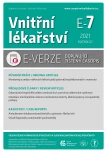Recommendations for safe collection of venous blood by a closed collection system
Authors:
Beáta Bolerázska 1; Anna Birková 2; Beáta Čižmárová 2
Authors‘ workplace:
Univerzita Pavla Jozefa Šafárika v Košiciach, Lekárska fakulta, 1. stomatologická klinika LF UPJŠ
1; Univerzita Pavla Jozefa Šafárika v Košiciach, Lekárska fakulta, Ústav lekárskej a klinickej biochémie LF UPJŠ
2
Published in:
Vnitř Lék 2021; 67(E-7): 8-12
Category:
Review Articles
Overview
In recent years, data have been repeatedly published stating that most errors in the process of obtaining a laboratory result occur in the pre-analytical phase (46 % to 68.2 %). This is an area that is usually out of direct control of the laboratory, involving venous blood collection (phlebotomy). The detection of these errors is considered to be quite difficult and can therefore easily lead to a misinterpretation of laboratory results with a consequent adverse effect for the patient and even in unintended injury. The most effective way to prevent them is to have a good knowledge of the current blood collection recommendations, which were recently (2018) revised by the European Federation for Clinical Chemistry and Laboratory Medicine (EFLM) and are offered in this review.
Keywords:
recommendations – closed blood collection system – patient preparation – venous blood collection
Sources
1. Hallworth MJ. The ’70% Claim’: What is the evidence base? Ann Clin Biochem. 2011; 48(6): 487–8. PMID: 22045648.
2. Ngo A, Gandhi P, Miller WG. Frequency that Laboratory Tests Influences Medical Decisions. J App Lab Med. Accessed 9/19/17.
3. Simundic AM, Bolenius K, Cadamuro J et al. On behalf of the Working Group for Preanalytical Phase (WG‑PRE), European Federation of Clinical Chemistry and Laboratory Medicine (EFLM). EFLM recommendation of venous blood sampling v 1.1, October 2017.
4. Simundic AM, Bölenius K, Cadamuro J et al. Joint EFLM‑COLABIOCLI recommendation for venous blood sampling. Clin Chem Lab Med 2018; 56: 2015–2038.
5. Lippi G, Salvagno GL, Montagnana M et al. Influence of short‑term venous stasis on clinical chemistry testing. Clin Chem Lab Med 2005; 43: 869–75. Lippi G, Salvagno GL, Montagnana M, Franchini M, Guidi GC. Venous stasis and routine hematologic testing. Clin Lab Haematol 2006; 28: 332–337.
6. Mehmood Z, Muhammad Mubeen S, Shehzad Afzal M et al. Potential Risk of Cross‑Infection by Tourniquets: A Need for Effective Control Practices in Pakistan. Int J Prev Med. 2014; 5(9): 1119–1124.
7. Pinto AN, Phan T, Sala G et al. Reusable venesection tourniquets: a potential source of hospital transmission of multiresistant organisms. Med J Aust. 2011; 195(5): 276–279.
8. Culjak M, Gveric Grginic A, Simundic AM. Bacterial contamination of reusable venipuncture tourniquets in tertiary‑care hospital. Clin Chem Lab Med 2018; 56: e201–e203.
9. Lima‑Oliveira G, Lippi G, Salvagno GL et al. New ways to deal with known preanalytical issues use of transilluminator instead of tourniquet for easing vein access and eliminating stasis on clinical biochemistry. Biochem Med 2011; 21(2): 152–159.
10. Lima‑Oliveira G, Lippi G, Salvagno GL et al. Transillumination: a new tool to eliminate the impact of venous stasis during the procedure for the collection of diagnostic blood specimens for routine haematological testing. Int J Lab Hematol. 2011; 33(5): 457–462.
11. Lima‑Oliveira G, Salvagno GL, Lippi G et al. Elimination of the venous stasis error for routine coagulation testing by transillumination. Clin Chim Acta. 2011; 412(15–16): 1482–1484.
12. Cornes M, van Dongen‑Lases E, Grankvist K et al. Order of blood draw: Opinion Paper by the European Federation for Clinical Chemistry and Laboratory Medicine (EFLM) Working Group for the Preanalytical Phase (WG‑PRE). Clinical Chemistry and Laboratory Medicine (CCLM), 2017; 55(1): 27–31.
13. AccuVein Learning Center. (n.d.). Considerations When Selecting an IV Needle. Retrieved July 22, 2021, from https://learn.accuvein.com/article/selecting‑an‑ iv‑needle‑size/
14. Mock KJ, Crist RA, Hansen SJ et al. Discard tubes are not necessary when drawing samples for specialized coagulation testing. Blood Coagul Fibrinolysis 2010; 21: 279–282.
15. Loeffen R, Kleinegris MC, Loubele ST, Pluijmen PH, Fens D, van Oerle R, ten Cate H, Spronk HM. Preanalytic variables of thrombin generation: towards a standard procedure and validation of the method. J Thromb Haemost. 2012; 10: 2544–2554.
16. Šigutová ZP, Fátorová I, Hrachovinová I et al. (n.d.). Doporučení laboratorní sekce České hematologické společnosti ČLS JEP Preanalytika v hematologické laboratoři. Retrieved July 22, 2021, from http://www.hematology.cz/doporuceni/laboratorni_ sekce/files/obecna/Doporuceni_LS_CHS_CLS_JEP‑Preanalytika_ v_hematologicke_ laboratori_v01.pdf
17. Kitchen S, Olson JD, Preston FE. Quality in Laboratory Hemostasis and Thrombosis. Bognor Regis: Wiley‑Blackwell, 2nd Edition. 2013; 22–44.
18. Smock KJ, Crist RA, Hansen SJ et al. Discard tubes are not necessary when drawing samples for specialized coagulation testing. Blood Coagul Fibrinolysis. 2010; 21: 279–82.
19. Loeffen R, Kleinegris MC, Loubele ST et al. Preanalytic variables of thrombin generation: towards a standard procedure and validation of the method. J Thromb Haemost. 2012; 10: 2544–54.
20. Guder WG, Narayanan S. Pre‑ Examination Procedures in Laboratory Diagnostics: Preanalytical Aspects and Their Impact on the Quality of Medical Laboratory Results. De Gruyter; 2015.
21. Harrison P, Mackie I, Mumford A et al. British committee for standards in H. Guidelines for the laboratory investigation of heritable disorders of platelet function. Br J Haematol. 2011; 155: 30–44.
22. Adcock DM, Kressin DC, Marlar RA. Minimum specimen volume requirements for routine coagulation testing: Dependence on citrate concentration. Am J Clin Pathol. 1998; 109: 595–599.
23. Chuang J, Sadler MA, Witt DM. Impact of evacuated collection tube fill volume and mixing on routine coagulation testing using 2.5 mL (pediatric) tubes. Chest. 2004;126:1262–1266.
Labels
Diabetology Endocrinology Internal medicineArticle was published in
Internal Medicine

2021 Issue E-7
Most read in this issue
- Amiodarone induced pulmonary toxicity
- Amanita phalloides intoxication: mechanism of toxicity, clinical manifestations and therapeutic approaches
- Pitfalls of diagnosing autoimmune pancreatitis
- Recommendations for safe collection of venous blood by a closed collection system
